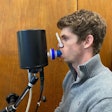
Material obtained from nasal lavage can provide a basis for assessing COPD and could lead to a simple diagnostic method for early detection and treatment.
That’s according to the study, “Nasal Production of IL-26 Involving T Cells In Smokers With and Without COPD,” published in the Journal of Allergy and Clinical Immunology. Researchers at Karolinska Institutet and Karolinska University Hospital in Sweden have shown that elevated levels of the protein interleukin-26 (IL-26) in the nose of smokers both with and without COPD can be used to assess patients with an early phase of the disease.
The researchers said in a news release that IL-26 is a cytokine that is important for cell communication in the immune system. It also has a direct inhibitory effect on bacteria and viruses and can influence inflammation and immune responses. IL-26 has previously been linked to various inflammatory diseases, including COPD, where patients with the disease have been shown to have elevated levels of IL-26 in the lower respiratory tract.
In the study, researchers focused on understanding how IL-26 is produced in the nose of smokers and what the levels say about individual COPD patients.
“We have discovered that IL-26 is produced in greater amounts in the noses of smokers with COPD compared to non-smokers, while smokers without COPD showed a tendency towards increased levels,” said first author Julia Abrero, MD, a researcher at the Department of Clinical Science, Intervention and Technology in the Karolinska Institutet and physician at Karolinska University Hospital. “This suggests that IL-26 may be an important factor in the inflammatory process underlying COPD.”
The study contained 50 participants, including active habitual smokers with mild to moderate COPD and without COPD and a control group of healthy non-smokers. Patients with other lung diseases were excluded.
The participants underwent a simple nasal lavage so that the researchers could analyze the presence of IL-26 in the nose. The measured levels were found to reflect inflammation of the lower respiratory tract, as well as























